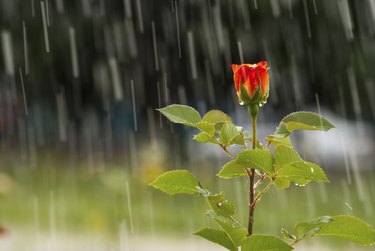
With chlorine added to many public water systems, it might seem that "water, water everywhere but not a drop to drink" is the order of the day for your garden. While chlorine does kill microorganisms that are necessary to your plants' growth, the levels in drinking water are so low and the beneficial beasties multiply so quickly that most gardeners can cross this worry off their list.
Chlorine Kills Bacteria
Video of the Day
Some 98 percent of all U.S. water utilities add chlorine to public water systems to kill off bacteria, and they have done so for decades. Still, scientists don't understand the chemical's mechanism for destroying bacteria. Nevertheless, chlorinated water has effectively eliminated microbial waterborne pathogens in this country, including those causing typhoid fever, cholera, dysentery and Legionnaires' disease.
Video of the Day
Chlorine Isn't Toxic in Small Quantities
Gardeners know that chlorine kills bacteria and fear that chlorinated water will not make the garden happy. In fact, chlorinated water kills microorganisms in garden soil and compost piles, organisms beneficial to plant growth and health. However, because the chlorine level is so low, the damage done is minimal. According to an article published by the Colorado State University Extension, treated water typically contains 0.05 to 0.90 parts of chlorine per million. Water must contain some 65 parts per million to kill soil microorganisms at a depth of 6 inches.
Chlorine Holds Tight to Surface Particles
One reason chlorinated water has little effect is that the chemical binds to soil-particle surfaces. This means that chlorine may kill off microorganisms in the upper few inches of soil, but lower levels of soil are not affected. While the water seeps on down, the chlorine does not. Even heavily chlorinated water -- 5 parts per million -- impacts microorganisms in only the top half inch of soil, according to a Colorado State University Extension article.
Microorganisms Reproduce Like Rabbits
Microorganisms hidden in dark garden soil reproduce early and often. This makes them more than a match for the bacteria killers in chlorine. A Colorado State University Extension article mentions a study in which researchers irrigated soil with highly chlorinated water for 126 days straight. Just 48 hours after they ceased watering, the soil microorganism populations rebounded to their before-treatment levels for all depths of soil.
Heavily Chlorinated Water Is Toxic
Swimming pool water can contain far more chlorine than drinking water, so don't drain your pool into the veggie patch. The effect of the chlorine on plants depends on the chlorine level in the water, but testing isn't mandatory. Since chlorine dissipates quickly, if you stop adding chlorine to your pool, in a week or 10 days, the chlorine level will have dipped to below that of drinking water.
- Colorado State University Extension: Impact of Watering Lawns and Gardens With Chlorinated Water
- Spectrum Analytic: Chlorine in Pool Water and Nearby Plants
- Missouri Botanical Garden: Gardening FAQs
- Pennsylvania American Water: Fact Versus Fiction
- University of California Scienceline: What Is the Effect of Chlorinated Water on Plant Growth?